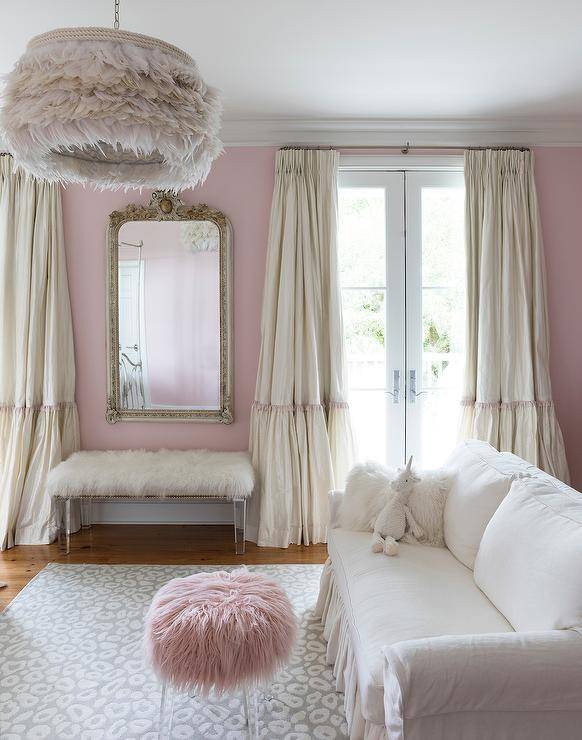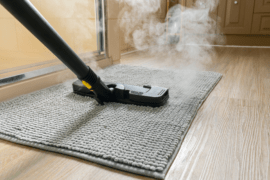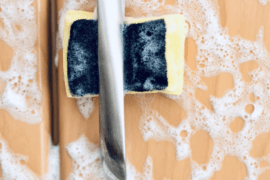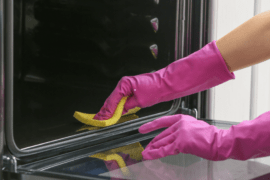When it comes to the furniture in the home, couches encounter the most wear and tear. We use them daily to sit on and relax, watch our favorite TV shows and even nuzzle up with our family and pets. In some houses, couches are even used as makeshift beds for guests. So all this action can turn your favored spot into a desirable place for germs, dirt, and more. This is why it’s crucial to learn how to clean a couch and to ensure that you are doing it regularly.

If you’re only cleaning your couch when you need to extract a stain, that’s a blunder. Cleaning a couch should be incorporated into a weekly cleaning schedule. This will help to make your couch last longer and look brand-new again. How you clean a couch relies on the precise material it’s made from—and if you clean it the wrong way, you might ruin it. In this article, we have all the information you will need to ensure that you clean your couch correctly.
Importance of Cleaning the Couch
It’s essential to understand why you need to clean your couch first. There are three main reasons couch cleaning is a must. The first, of course, is about protecting your expensive purchase. Furniture is an investment, and therefore it is essential to maintain its appearance.
But the other two reasons have to do with your well-being. Allergens such as fleas, mold, dust mites, and bacteria can live in the fibers of your couch, and if left for long periods of time, they can hurt your health. Further, your couch can hold massive amounts of dust, and when you sit on the cushions, this dust is released into the air. So, if you’re not vacuuming your couch regularly, you’re probably breathing in dust.
Cleaning Frequency
How often you clean your couch is almost as important as how you clean it. To keep yours in tip-top shape, deep-clean it every three to six months. But it is also recommended to vacuum your sofa at least once a week—more if you have pets—and spot-cleaning as required.
Cleaning frequency should hinge on how much you use your couch and who uses it. In addition to pets, little children manage to get things messier faster. The color of your sofa is also an element. White, ivory, or beige sofas, of course, tend to need more care than darker colors.
Cleaning Supplies
- Warm water
- Natural-bristle fabric brush
- Microfiber cloth
- Natural dish soap
- Spray bottle
- White vinegar
- Castile soap
- Leather Honey
- All-purpose cleaner
- Handheld vacuum or vacuum with attachments
Tackling Stains
Even though you may want to put in some elbow grease and scrub, doing so may push the stain further into the fabric, sealing it into the couch. Even if you get the stain out, rubbing too hard may also damage the couch fabric’s texture, leaving behind a different kind of unappealing mark. Patting, laying a cloth on it, and letting it absorb naturally, are all ways to help ensure that it’s not going to sink in and infect as many layers as possible.
Your immediate goal, if you’re trying to do a quick fix for a stain that just happened, is to work with a dry towel. You want to get up as much of that substance as possible, whether with a dry washcloth, a dry towel, or a dry paper towel.
Step One for All Couches
For any type of couch, the first step is always the same—you want to start by removing the cushions from the couch. Once you have removed the cushions, use a vacuum to clean under and around the cushions. You can also use a dry natural-bristle brush to loosen dirt and dust gently.
Next, you will want to read the fabric care labels to see if the cushion covers are machine washable. In general, couch cushion covers should be cleaned in cold water either by hand or on a delicate cycle in the washing machine.
Nevertheless, be cautious when it comes to drying them. A common complaint, even with machine-washable covers, is that they tend to shrink in the dryer and fit the cushions too tightly afterward. Air-drying might be a better option.
How to Clean a Linen Couch
- Begin by reading the care labels of your linen couch to determine what solution you can use on it.
- Vacuum your sofa to remove all dirt and dust.
- To spot-clean an area, gently blot the stain with a damp cloth. Do not rub or scrub, as this may ruin the material.
- If your sofa needs a more thorough cleaning, you can hand-wash the linen coverings or put them in the washing machine on a warm temperature with a mild natural detergent.
- You will probably want to stay far away from the dryer — read the instructions carefully beforehand. Typically, the safest method is air drying.

How to Clean a Microfiber Couch
- Begin by reading the care label of your microfiber couch to determine what solution you can and cannot use on it.
- Vacuum or brush your sofa to remove all dirt and dust.
- Depending on your couch’s care label, use a natural cleaner, which you can make at home using 1 Tbsp. natural dish soap and 2 cups of warm water in a spray bottle.
- Lightly spray the solution on the stained areas, and then gently blot them with a dry cloth.

If your microfiber couch feels rigid after cleaning, gently soften it by using a soft, natural-bristle brush to fluff the fibers.
Rubbing alcohol is also excellent for microfiber couches because it evaporates quickly and doesn’t leave water stains behind – If you go this route add a little rubbing alcohol to your spray bottle, saturating the stain with the solution and then gently rub away the stain.
How to Clean a Wool Couch
- Begin by reading the care label of your wool couch to determine what solution you can and cannot use on it.
- Vacuum the sofa to remove all dirt and dust. You can also use a dry natural-bristle brush to loosen dirt and dust.
- Wool couches are generally labeled with a “W,” with the label specifying whether the fabric is a blend or 100% wool.
- Most wool couches should be cleaned only with water so use a damp towel or cloth and gently scrub in a circular motion to remove any dirt or dust. (If you use a couch cleaner, you might permanently damage the sofa.)
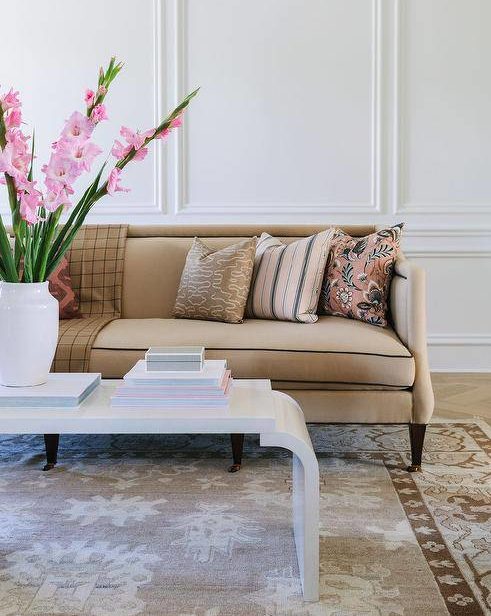
How to Clean a Synthetic Fabric Couch
- Begin by reading the care labels of your fabric couch to determine what solution you can use on it.
- Vacuum your sofa to remove all dirt and dust. You can also use a dry natural-bristle brush to loosen dirt and dust.
- Mix together 2 cups of water, 1 Tbsp. dish soap and 1 Tbsp. white vinegar in a spray bottle. You can also use an all-purpose cleaner since synthetic fabrics are generally sturdier and stain-resistant.
- Spray the sofa or just the stains with your solution, depending on how dirty your sofa is, but make sure the stains are saturated with the solution.
- Once the sofa is saturated, dampen a microfiber cloth with more solution and gently dab at any stains.
- Blot the area with a dry paper towel or microfiber cloth to help lift the stains.
- Do not rub, as you may rub the stain in instead of removing it.

How to Clean a Faux-Leather Couch
- Begin by reading the care labels of your faux-leather couch to determine what solution you can use on it.
- Vacuum it to remove all dirt and dust.
- Mix 2 cups of water and 2 Tbsp. castile soap, and put the solution in a spray bottle.
- Castile soap is recommended for faux leather and leather couches. It is plant-based and will not dry out the leather as other soaps may
- Spray the stain, then wipe or lightly scrub it.
- Dry the area using a hair dryer, or blot it with a dry towel.

How to Clean a Leather Couch
This is possibly the easiest couch to clean. It simply needs to be wiped down after each use or when a stain is present.
- Vacuum your sofa to remove all dirt and dust.
- Mix a solution of equal parts water to white vinegar in a spray bottle. Alternatively, you can also use mild soapy water made with plain dish soap.
- Lightly spray the solution all over the couch.
- Use a microfiber cloth to rub the solution onto the couch in circular motions lightly.
- Use a clean towel to dry it.
- You can also try using Leather Honey, a nontoxic leather cleaner and conditioner. Place a quarter-size drop of leather cleaner on a lint-free cloth, spot-test it in a discreet area, and allow your test area to dry. If everything’s fine, coat your leather in a thin, even layer of conditioner.

How to Clean a Velvet Couch
With velvet furniture, you should always spot-clean instantly after a spill. Place a microfiber cloth or paper towel on the spill to absorb it. Leave it there until the entire spill has been absorbed. Always start with a microfiber cloth, especially when dealing with velvet.
The best way to keep your velvet couch clean is to steam-clean it regularly. Gently apply your steamer to the sofa and work your way down. You can use a clothes steamer or one made for upholstery.
If you don’t have a steamer, create a natural solution:
- Mix 1 tsp. natural dish soap with 1 cup of warm water in a bowl — make sure you mix it, so there are bubbles.
- Dip a microfiber cloth into the solution.
- Lightly blot your stain until you have removed most of it.
- Allow the cleaned area to dry for at least 30 minutes.
Note: Velvet material can discolor, so try to dry it out of direct sunlight.

How to Clean a Silk Couch
For a silk couch, you want to make sure you are very careful. Silk fabric can be a little trickier than other fabrics, as it can get damaged more easily. Sometimes when silk is wet, the dye can come off, so it is important to check first what solutions you can use.
- Begin by reading the care label—and read it twice, just to be double sure which cleaning products you can use.
- Vacuum your sofa to remove all dirt and dust.
- Use a simple solution of 2 cups of cold water mixed with 1 Tbsp. mild laundry detergent. Alternatively, you can mix water and vinegar. But it is recommended to do a patch test before using either. If there aren’t any color transfers, you can continue.
- Dip a soft cloth into your solution and gently blot at any stains. Avoid dousing the fabric, or you might ruin the sofa or discolor it.
- Use a hairdryer to dry the area and prevent any water stains from forming.
- Note: If you are unsure about silk fabrics, you should get them professionally cleaned.
